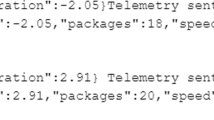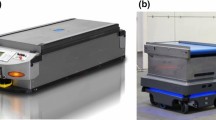Abstract
Supervisory controllers have traditionally coordinated the various resources of manufacturing systems, such as flexible manufacturing workcells, for the production of a priori set families of part types. This paper expands on this capability by allowing the control of the production of new part types side by side with previously defined and planned for nominal part types. The proposed basic workcell supervisory-control approach advocates the use of a pair of non-communicating independent supervisors, synthesized individually but working in concert, to achieve the production of existing and new part types: nominal and complementary supervisors, respectively. The nominal supervisor is responsible for controlling the behavior of the nominal system, producing the set of a priori planned-for part types, whereas the complementary supervisor controls the flow of the a priori unplanned-for new part types.
Similar content being viewed by others
References
Cassandras, C. G. and Lafortune, S., Introduction to Discrete Event Systems, Kluwer Academic Publishers, Boston, MA (1999).
Cieslak, R., Desclaux, C., Fawaz, A. S., and Varaiya, P., “Supervisory Control of Discrete-Event Processes with Partial Observation,” IEEE Transactions on Automatic Control, Vol. 33,No. 3, pp. 249–260 (1988).
Daltrini, A. M. and Kumara, S. R. T., “FMS Modeling Using Timed Extended Moore Machine Network,” Japan-USA Symposium on Flexible Automation, Boston, MA, pp. 1539–1546 (1996).
Duan, N., Kumara, S. R. T., and Madeiros, D. J., “EMM-Network Model for FMS Modeling, Simulation, and Control,” Second Annual Conference on AI, Simulation, and Planning in High Autonomy Systems, Cocoa Beach, FL, pp. 253–262 (1991).
Garcia, H. E., Ray, A., and Edwards, R. M., “A Reconfigurable Hybrid System and its Application to Power Plant Control,” IEEE Transaction on Control Systems Technology, Vol. 3,No. 2, pp. 157–170 (1995).
Hagi-Valizadeh, A. and Loparo, K. A., “Minimizing the Cardinality of an Events Set for Supervisors of Discrete-Event Dynamical Systems,” IEEE Transactions on Automatic Control, Vol. 41,No. 11, pp. 1579–1593 (1996).
Hopcroft, J. E. and Ullman, J. D., Introduction to Automata Theory, Languages, and Computation, Addison Wesley, Reading, MA (1979).
Kannan, V. R., “A Virtual Cellular Manufacturing Approach to Batch Production,” Decision Sciences, Vol. 27,No. 3, pp. 519–539 (1996).
Kumar, R. and Garg, V. K., Modeling and Control of Logical Discrete Event Systems, Kluwer Academic Publishers, Boston, MA (1995).
Lawley, M., “Deadlock Avoidance for Production Systems with Flexible Routing,” IEEE Transactions on Robotics and Automation, Vol. 15,No. 3, pp. 497–510 (1999).
Leung, Y.-T. and Sheen, G.-J., “Resolving Deadlocks in Flexible Manufacturing Cells,” Journal of Manufacturing Systems, Vol. 12,No. 4, pp. 291–304 (1993).
Lewis, F. L., Pastravanu, O. C., and Hung, H.-H., “Controller Design and Conflict Resolution for Discrete Event Manufacturing Systems,” IEEE Conference on Decision and Control, San Antonio, TX, pp. 3288–3293 (1993).
Lin, F. and Wonham, W. M., “On Observability of Discrete Event Systems,” Journal of Information Sciences, Vol. 44,No. 3, pp. 174–198 (1988).
Moody, J. O. and Antsaklis, P. J., “Deadlock Avoidance in Petri Nets with Uncontrollable Transitions,” American Control Conference, Philadelphia, PA, pp. 1257–1258 (1998).
Prosner, J. H., Kam, M., and Kwatny, H. G., “Online Supervisor Synthesis for Partially Observed Discrete-Event Systems,” IEEE Transactions on Automatic Control, Vol. 43,No. 11, pp. 1630–1634 (1998).
Qui, R. G. and Joshi, S. B., “A Structured Adaptive Supervisory Control Methodology for Modeling the Control of a Discrete Event Manufacturing System,” IEEE Transactions on Systems, Man, and Cybernetics-Part A: Systems and Humans, Vol. 29,No. 6, pp. 573–586 (1999).
Ramadge, P. J. G. and Wonham, W. M., “Supervisory Control of a Class of Discrete Event Systems,” SIAM, Journal of Control and Optimization, Vol. 25,No. 1, pp. 206–230 (1987).
Ramirez-Serrano, A., “Extended Moore Automata for the Supervisory Part-Flow Control of Virtual Manufacturing Workcells,” Ph.D. Dissertation, Department of Mechanical and Industrial Engineering, University of Toronto (2000).
Ramirez-Serrano, A. and Benhabib, B., “Supervisory Control of Multi-Workcell Manufacturing Systems with Shared Resources,” IEEE Transactions on Systems, Man, and Cybernetics: Part B, Cybernetics, Vol. 30,No. 5, pp. 668–683 (2000).
Ramirez-Serrano, A., Sriskandarajah, C., and Benhabib, B., “Control of Flexible-Manufacturing Workcells Using Extended Moore Automata,” IEEE International Conference on Robotics and Automation, Detroit, MI, pp. 120–125 (1999).
Ramirez-Serrano, A., Sriskandarajah, C., and Benhabib, B., “Automata-Based Modeling and Control Synthesis for Manufacturing Workcells with Part-Routing Flexibility,” IEEE Transactions on Robotics and Automation, Vol. 16,No. 6, pp. 807–823 (2000).
Ramirez-Serrano, A., Zhu, S. C., and Benhabib, B., “Moore Automata for the Supervisory Control of Robotic Manufacturing Workcells,” Journal of Autonomous Robots, Vol. 9,No. 1, pp. 59–69 (2000).
Ramirez-Serrano, A., Zhu, S. C., Chan, S. K. H., Chan, S. S. W., Ficocelli, M., and Benhabib B., “A Hybrid PC/PLC Architecture for Manufacturing-System Control—Theory and Implementation,” Journal of Intelligent Manufacturing, Vol. 13,No. 4, pp. 261–282 (2002).
Reveliotis, S. A. and Ferreira, P. F., “Deadlock Avoidance Policies for Automated Manufacturing Cells,” IEEE Transactions on Robotics and Automation, Vol. 12,No. 6, pp. 846–857 (1996).
Reveliotis, S. A., Lawley, M., and Ferreira, P. F., “Polynomial Complexity Deadlock Avoidance Policies for Sequential Resource Allocation Systems,” IEEE Transactions on Automatic Control, Vol. 42,No. 10, pp. 1344–1357 (1997).
Seifoddini, H., “A Probabilistic Model for Machine Cell Formation,” SME Journal of Manufacturing Systems, Vol. 9,No. 1, pp. 65–75 (1990).
Smith, J. S., Hobercht, W. C., and Joshi, S. B., “A Shop Floor Control Architecture for Computer Integrated Manufacturing,” IIE Transactions, Vol. 28,No. 10, pp. 783–794 (1996).
Takai, S., Ushio, T., and Kodama, S., “Static-State Feedback Control of Discrete Event Systems Under Partial Observation,” IEEE Transactions on Automatic Control, Vol. 40,No. 11, pp. 1950–1954 (1995).
Vakharia, A. J. and Kaku, B. K., “Redesigning a Cellular Manufacturing System to Handle Long-Term Demand Changes: A Methodology and Investigation,” Decision Sciences, Vol. 24,No. 5, pp. 909–929 (1993).
Wicks, E. M. and Reasor, R. J., “Designing Cellular Manufacturing Systems with Dynamic Part Populations,” IIE Transactions, Vol. 31,No. 1, pp. 11–20 (1999).
Zhou, M. C., DiCesare, F., and Rudolph, D., “Design and Implementation of a Petri Net Supervisor for a Flexible Manufacturing System,” Automatica, Vol. 28,No. 6, pp. 1199–1208 (1992).
Author information
Authors and Affiliations
Rights and permissions
About this article
Cite this article
Ramirez-Serrano, A., Benhabib, B. Supervisory Control of Functionally-Expandable Manufacturing Systems. International Journal of Flexible Manufacturing Systems 15, 241–271 (2003). https://doi.org/10.1023/A:1026321126865
Issue Date:
DOI: https://doi.org/10.1023/A:1026321126865




